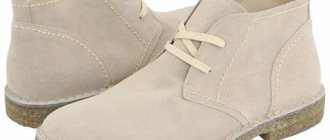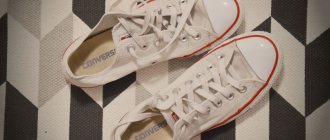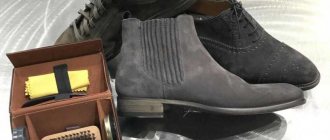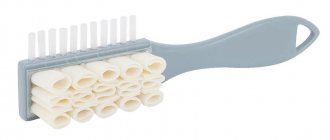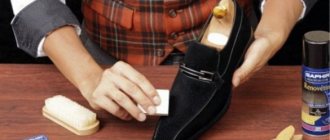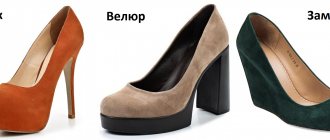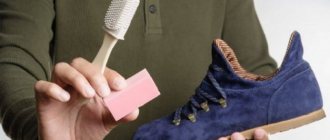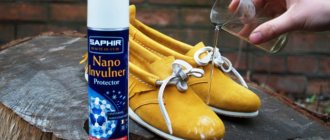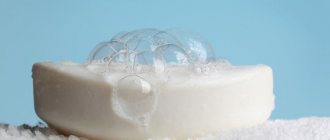Suede is a rather capricious material, which, despite being difficult to care for, has become widespread among fashionistas. Whatever item is made from it, it looks expensive and elegant.
However, if used incorrectly, a product made from such leather will very quickly lose its presentation, and not every owner knows how to clean suede correctly.
There are a number of nuances that you have to take into account in order to wear an item and enjoy it for as long as possible. After reading them in our article with photos, you will not only learn about the rules of care, but also how to return the products to a presentable appearance.
Direct methods
Basically, suede shoes “suffer” in the autumn-winter period under the pressure of weather conditions and the human factor (coating roadways with special components), and that is why they require close attention.
There are several modern methods that allow you to get rid of dirt and salts on delicate surfaces.
Hard sponge
If you are just going to buy boots made of natural suede, then pay attention to sponges for cleaning them. Unlike those designed for smooth skin, they have a porous and rather dense structure.
Using this kind of equipment will not damage the texture of the material and will help you easily deal with unwanted particles of sand or dirt. It is enough just to pass the sponge over the product in one direction in a timely manner, excluding multidirectional friction.
Eraser
An ordinary stationery eraser removes stains from a suede surface quite carefully. To achieve results, you must actively rub the damaged area.
Brush with rubber or rubber teeth
You can also find a special brush with rubberized bristles on sale. The principle of its operation is reminiscent of using an eraser.
Many such devices are additionally equipped with a soft brush on the opposite side, which allows you to delicately remove grains of dirt.
Crepe brush
Over time, suede begins to become shiny from exposure to moisture. To avoid this phenomenon, you must regularly use a crepe brush. It gently lifts the fibers, so that the surface regains its original appearance.
Compact brush with eraser
This product should be purchased and put in your purse just in case. Having the device at hand will allow you to get rid of contamination immediately, without waiting for you to return home.
With such a brush you can effortlessly renew the top layer and give it a characteristic velvety feel.
Office shoe shine machines
If funds allow and you have more than one pair of suede shoes in your wardrobe, it makes sense to purchase a special cleaning device.
The process of operating this device is quite simple - as soon as you place your shoes in a special compartment equipped with brushes, the sensor reacts, and cleaning of the product begins, not accompanied by extraneous sounds.
In addition, you can easily use creams that will automatically be distributed in an even layer over the surface.
Important: it is recommended to clean suede only when it is dry. Therefore, if you had to get your shoes pretty wet while walking, wait until the material dries.
Rules for daily care of suede shoes
Already when purchasing such a pair, sellers offer to take a protective aerosol with it, as well as a special brush for the soles. You shouldn’t refuse, because they will come in handy for cleaning purchased shoes every day and caring for them properly. This will allow you to maintain its attractive appearance longer.
Rice. 1 - Using a water-repellent spray
Before going outside for the first time, clean the suede with the rubber bristles of a brush and apply 3 coats of water-repellent spray. Such a film will not be noticeable on the shoes, but will help prevent getting wet and protect from dirt. Shoes will be easy and proper to clean, since dirt will not penetrate deeply.
Some useful tips for caring for suede shoes:
- Wear it only in dry weather. If men's or women's old velor shoes do get very wet, dry them thoroughly before cleaning.
- For drying, use a special shoe or fill the space inside with paper, and for light-colored shoes only white napkins are used. They need to be changed as they get wet.
- After drying, clean the dirt with a stiff brush, a foam cleaner, and then go over it with a rubber brush.
Use a separate brush for each suede color. Remove dirt by moving the brush in one direction, and when cleaning the abrasion, move the bristles in different directions. To restore color, use aerosol paints. Treat the surface in advance, not just before going outside. To treat children's felt boots, special sprays are suitable, such as those used when caring for shoes at home.
How to clean different types of dirt?
Depending on the type and degree of stains, the recipes for how to clean suede shoes with or without fur differ. A special brush can be a good helper in cleaning - on one side it has soft teeth made of rubber or rubber, on the other - hard ones made of metal, on the sides of the product there are natural soft bristles.
Rice. 2 — Brush for cleaning suede shoes
The rubber part lifts the pile, eliminates grime, and the metal fights dried dirt. Do not press the brush too hard; work carefully. A more careful cleaning method is to use a crepe brush. If the tool has a side wheel, use it to clean the welt and seams. Instead of a brush, a stationery eraser is quite suitable.
Machine oil and reagents
These substances can remain on shoes after walking on asphalt. They can be easily removed with a rubber brush or eraser. Before removing stains, sprinkle greasy marks with talcum powder and scrub the surface with stiff bristles.
Whiteness, shine, fuel oil, glue and paint
Acetone can be used to remove such stains. First test its effect on an inconspicuous area of the shoe. If stains (for example, from moment glue) have already dried, carefully remove them with a knife or abrasive paper.
Bitumen, shoe polish and tar
Sprinkle starch onto greasy stains and wash with water and soap to remove any residue. Repeat in several stages, do not wet the shoes too much. Then dry and apply a colorless impregnation to protect against moisture.
Wax, candle, resin and paraffin
Remove the dried stain with a knife or place the shoes in the freezer - this will cause the wax to freeze and chip off. Then combine 10 g of wine alcohol, 35 ml of ammonia and 50 g of purified gasoline. Soak a cotton pad in the mixture and remove any remaining paraffin.
Rice. 3 — Removing paraffin from suede
Juice, champagne or vomit
Sprinkling baking soda can help get rid of spilled drinks or vomit on your shoes. Wait for the stain to dry and brush it off. Clean light-colored shoes with a soda-milk solution (1 tbsp per liter). After 2 minutes, wipe with a soft cloth.
How to clean after rain or snow?
Exposure to water may leave stains on suede shoes. Combine equal parts of warm water, ammonia and hydrogen peroxide, soak a cotton pad in the mixture and rub the stain. If your shoes are dark, you can simply rub away the stains with an eraser.
Grass, plaque and blood
Streaks and traces of them can be removed with a gentle solvent - a special nail polish remover without acetone. Rub the stained area first with a dry and then with a clean, damp cloth. For best results, treat the stain from the edges to the middle.
Solid oil
Wash off a greasy stain from fuel and lubricant on winter or summer shoes with a soap solution or dishwashing liquid, for example, “Fairy”. Or wash it with hydrogen peroxide, and then scrub it thoroughly with a soft brush.
Rice. 4 — Means for cleaning grease stains
Coffee and soot
Dark stains on white shoes can be removed with soda or milk solution, or bread crumb. It is especially important to clean up your light-colored summer shoes before putting them away for the winter. If stains appear on dark shoes and nubuck material, you can rub them with nail polish remover that does not contain acetone.
How to remove scuff marks?
You can eliminate bald spots on suede and return the shiny surface to normal using a special spray. It is sold in professional stores and is applied from a distance of 20-25 cm. To refresh the color of dark shoes, use coffee grounds; for white shoes, use talc. Apply the product to the surface, remove excess with a dry soft cloth.
How to remove grime and odor?
Greasy shoes can be saved with a 9% vinegar solution. Wipe your shoes with it, then go over the dirty areas with an unpleasant odor with a rubber band. After airing, you can safely put on an updated pair of shoes.
How to clean dried dirt?
You will be able to clean very dirty shoes from heavily ingrained dust only after the wet pair has dried. It will be necessary to wipe the contaminated areas with a soap solution with ammonia (1:5), rinse the contaminated surface with cold water and remove the residue with a dry cloth. It is important to completely remove all traces of cleaning products. If there is heavy dirt, use professional products to remove stains from the pile - cleaning foam, aerosol.
Rice. 5 – Foam shoe cleaner
How to clean from dust?
Dusty, shiny and worn shoes can be updated with your own hands. To do this, you need to wipe the suede with a solution of milk and soda (a teaspoon of powder per glass of liquid). Then sprinkle with fine salt and wipe with a weak solution of vinegar (1:4). Rinse off any remaining product with water.
How to remove shoe polish?
Immediately sprinkle the greasy stain with talcum powder and remove the residue using purified gasoline and then a soap solution. If dirt remains, use an eraser or a special stain remover. After this, comb the pile with a brush.
Store-bought cleaning products
Any suede product requires high-quality care. And this applies not only to cleaning from dirt, but also to timely preventing stains.
The first thing you should do immediately after purchasing boots or shoes is to apply a special spray or paint of a suitable shade that helps repel moisture. This treatment will also prevent the products from becoming excessively dusty.
There are several excellent commercial products that will help keep your shoes presentable without much effort, of which the following products can be distinguished:
- “Salton Expert”, “Antisol”, “Dividik”, “Silver Premium” are those spray sprays that will allow you to saturate shoes with a special protective layer that prevents the penetration of moisture, reagents and salts.
- “Duke Velor Nubuck” is great not only for suede, but also for other pile leathers. The product is presented in the form of a liquid cream that has an effect similar to sprays. Even if you calculated the amount incorrectly, you can always remove the excess without adversely affecting the quality of the material.
- Foam "Salton" or "Salamander Cleaner" allows you to get rid of dirty stains and restore the former shine of a pair of shoes.
- “Renovator” is a special color for suede, which is applied directly to the dirt itself (unlike the previous ones, which need to be sprayed only on a clean surface), and only then cleaned off with a soft brush.
Advice: before cleaning light suede or, for example, red suede boots, pay attention to the coloring of the purchased product. For this type of shoe, only colorless products are acceptable.
Preventive treatment against dirt and stains
Suede must be treated with a compound that will protect it from dust, grease stains and water. Although suede itself is a waterproof material, moisture along with dissolved dirt still settles on its surface. Because of this, difficult-to-remove stains appear. To prevent their formation, you should purchase a special water-repellent compound at any shoe store.
Suede treatment products are sold in the form of sprays. The composition must be sprayed over all external surfaces of dry and clean shoes. You can stop spraying when the material becomes slightly wet. After this, the new thing should be left for 10–12 hours in a well-ventilated, dry room so that the suede is completely dry. Some experts recommend using the impregnation three times with a break of 20 hours to achieve maximum effect.
Proper care will significantly extend the life of suede. It’s better not to skimp and immediately purchase impregnation, a double-sided brush for the material and foam for cleaning shoes.
5/5 — (2 votes)
Traditional methods for removing stains
If for some reason you do not have the opportunity to purchase store-bought products, or you need to clean your shoes immediately, then you can put the items in order using improvised means.
Vinegar
Despite its own aggressive properties, this product has consistently proven itself as a cleaner for many surfaces. It can also be used for the velvety coating of dressed natural suede.
However, it is recommended to give preference exclusively to a product with a low acid index (not higher than 9%). If you use essence, you risk completely ruining your favorite shoes.
To achieve results, blot a lint-free cloth with a small amount of vinegar and thoroughly wipe off the stain. Do not use cotton pads - they may leave lint on the surface.
Also, do not pour too much product - the suede should be only slightly damp, and not quite wet.
Thus, having ordinary vinegar in your arsenal, you don’t have to worry about how to clean light suede. This substance is also effective for products of any other shade.
Important: do not keep wet shoes made of this leather near radiators - such rough drying will cause the material to lose its velvety quality. Let it dry naturally, even if it takes much longer. To speed up the process, you can blot wet areas with napkins.
Starch
A paste of starch and ammonia will help deal with fairly old stains on suede boots.
To obtain the product, you need to mix the components in equal proportions (two teaspoons of each) and apply the mixture to the problem area. When the composition is completely dry, it should be cleaned with a soft bristled brush.
Coffee grounds
Thanks to its rather delicate abrasive particles, coffee grounds can cope with almost any contaminant. It is enough to actively rub the mixture into the stain, and then remove the remaining grains with a brush.
True, this folk method is only acceptable for brown shoes, because the grounds tend to stain the surface.
Ammonia
Ammonia combined with a soap solution will help restore the elegance of suede shoes.
Prepare saturated soapy water and add a couple of drops of ammonia to it. Dip a sponge into the resulting product and wipe the product.
Then go over it with a clean damp cloth and then a dry cloth. Leave to dry away from artificial heat sources.
Advice: if you are afraid of soap stains in the future, dilute the alcohol with the same amount of water and perform the necessary manipulations.
Crumb
You need to use the soft part of the bread together with a brush. To begin with, you should apply bread crumbs in a circle, and then walk over the top with bristles. Repeat the steps until the dirt is removed.
Soap and powder solution
If you decide to prepare a soap solution, then you should pay attention to the level of acid-base balance. It is recommended to make a cleaning liquid from more gentle products - it can be either soap or powder, or all together.
You should wipe off the dirt without applying much pressure so that the material is not overly saturated with foam, and after drying there are no whitish stains left.
Soda and milk
This method will return the appearance of the product to its original condition.
To do this, you need to dissolve a level teaspoon of food powder in 200 milliliters of warm milk and apply the resulting “cocktail” to the surface.
After partial drying, the material is wiped with a slightly damp rag, carefully lifting the fibers “against the grain.”
Removing greasy stains
If you find a greasy stain on shoes or any other item of clothing made from suede, you can use any product from a fairly large list. It all depends on what is at hand.
Among the components that actively absorb moisture are the following:
- Bulk powders - potato/corn starch, baby powder, medical talc.
- Special stain removers. One of the most popular is “Vanish” (preferably for colored fabrics). This also includes products for cleaning or washing woolen products.
- Vinegar or ammonia.
- Powder for cleaning teeth.
In order to achieve the result, it is preferable to preheat the absorbent in a dry frying pan and then sprinkle it on the stain. It is worth doing this in such a way that the bulk component does not go beyond the boundaries of the contamination - for example, cover it along the contour with thick cloth or paper. After some time, the powders are cleaned off along with the fat that has been absorbed into them.
Important: it is worth considering that the use of talc and powders is only suitable for removing newly formed stains.
If a drop of fat is noticed only now, but you cannot remember the moment of the incident, make a solution of ammonia with a saturated soap solution, which is prepared by dissolving soap shavings in a small amount of liquid.
When using vinegar, it is worth considering the ratio of components - it is not recommended to use the product in its pure equivalent. It will be enough to pour just a teaspoon of the substance per liter of water.
Advice: if, when using liquid products to get rid of stains, the surface of the suede begins to shine and loses its texture, use a household steam generator. If you don’t have one in your household equipment, an iron with a steaming function, or the same kettle, will do just fine.
How to clean light suede
Not every fashionista would risk purchasing white shoes made from such a “delicate” material.
However, if you were not afraid and bought incredibly chic shoes of this shade, then you should find out in advance how to clean light suede shoes at home.
For light material, you can use special brushes, an eraser, and crumb. However, if you use the latter, you should not use a piece of dark bread. To avoid any darkening, opt for baked goods of an identical color.
- In addition to the above methods, hydrogen peroxide in equal proportions with ammonia will do an excellent job of treating problem areas.
- Milk in combination with crushed chalk and magnesium will also help remove old stains from light-colored shoes. But when buying a dairy product, you should choose low-fat.
- Another remedy is ammonia. They treat the surface with it, and then go over the product with a damp cloth.
Features of care
This material can be of two types: artificial and natural. The latter has greater strength and better quality, but also costs accordingly. It is worth noting that both types require compliance with certain rules.
- Suede does not tolerate moisture; when wet, it swells and then becomes hard and brittle, so before wearing it is important to treat shoes and clothing with a water-repellent spray.
- Cleaning suede should begin with using a brush, this way you will refresh the appearance of the shoes and get rid of dust.
- It is prohibited to wash suede leather in a washing machine; you can only use wet cleaning.
The generalized rules are suitable for regular application to all things, however, we’ll talk in more detail about how to clean material from a variety of stains.
How to remove salt from suede
It is not uncommon for salt stains to appear on your favorite boots, especially during the wet season. In most cases, this is due to the treatment of streets with specific reagents.
You can deal with the problem using:
- ammonia;
- soap solution;
- crumb of bread;
- purchased product;
- vinegar.
Tip: To prevent boots or boots from deforming when exposed to moisture, periodically fill them inside with crumpled newspapers - this will help maintain their shape, especially during drying.
Salt removal
In winter, utility services treat roads and sidewalks with a special saline solution and reagents to make it more comfortable for pedestrians to move on ice. Such mixtures negatively affect the external condition and internal structure of shoes made of suede materials.
Gasoline and talc versus salt
You can deal with stains and stubborn stains using purified gasoline and talc.
At the first stage, the boots are treated with gasoline using a soft foam sponge. After treatment, the wet surface is covered with talcum powder. The powder should be kept on the shoes for at least 60 minutes. After time, the surface is cleaned of powder using a special brush. The final stage is drying: the boots should dry on their own at room temperature.
Vinegar
The second popular and truly effective method is to use 9% vinegar essence. Vinegar dissolves salt, which helps remove stubborn stains and stains. Using a rubber brush or sponge, the surface of the product is treated with vinegar. Once the salt solutions have been removed, the boots should be wiped with a damp, soft cloth. Finally, dry at room temperature.
Ammonia with starch
To remove old stains, a mixture of ammonia and potato starch is useful. Both components must be mixed until a homogeneous paste is formed. The resulting mixture is applied to the contaminated areas and left until completely dry. The process takes a few minutes. After drying, the pulp must be removed using a brush.
Attention! Cleaning processes must be carried out with rubber gloves.
How to restore scuff marks
You can find many videos on the Internet that tell in detail how to restore the natural texture of suede. Here are some of the most common solutions to the issue:
- The simplest thing is to use a steamer. Under the influence of high humidity and temperatures, the shiny fibers of the material will become softer and more pliable. They can be returned to their original position without any problems, even just by moving your hand.
- Fine table salt will also help cope with the problem, which should be carefully rubbed over the surface of the shoe and then removed with a brush.
- You can use a vinegar solution (1:4 with water). This composition is applied to the surface, then carefully washed off. Afterwards, the shoes are treated with a similar mixture in a weaker concentration - a teaspoon of vinegar per 1 liter of liquid.
- Another way is to treat the abrasions with a mixture of 1 tsp. soda with a glass of milk. Leave to dry.
Means and tools
The simplest thing is to purchase a sponge or brush for cleaning suede in a specialized store . This thing has a special structure of pores, it cleans out dust particles well and smoothes out villi without damaging the suede surface. There you can also find a roller for easy cleaning.
There are special sprays for suede. They are easy to use: just spray on the surface and wait a couple of hours, and then brush on . During the waiting time, the substance seems to “push” dirt to the surface, which can then be easily removed.
, a regular toothbrush does a good job of cleaning . Do not throw away old “tired” hygiene products; their soft “worn out” bristles are an excellent tool for processing suede. An eraser for erasing lead pencil will also work. It's just better to use white.
@businessinsider.com
Features of cleaning different types of shoes
There is no big difference in the nuances of such care. For example, if you are wondering how to clean suede sneakers, then the answer is simple - the same way as shoes.
The only thing worth considering is that sports shoes have laces, which often differ in color. In this case, the use of purchased drugs may cause a change in the shade of the surface, not for the better. Therefore, it is recommended to remove this part first.
There is no fundamental difference with boots and boots. True, in the case of high shoes, most often problem areas appear in the area of the foot and the boot. To avoid contrast, it is worth purchasing a paint that matches the palette, which will help even out the color.
We looked at the main ways to effectively care for suede shoes without leaving home. The main thing is to remember that you should consider regular care of such products as some kind of undeniable ritual. And then your beautiful shoes will last you more than one season.
What to clean with?
To care for suede boots, you need to purchase a special brush, which has rubber bristles on one side and metal bristles on the other. You can also use sponges for suede and nubuck, which are available in a wide range.
Brushes and sponges for cleaning suede
The most common home remedies for cleaning suede shoes are soap, hydrogen peroxide, ammonia, talc or tooth powder.
Shoes made of natural suede
Natural suede requires careful care. It gets wet easily, and when it dries, it loses its original appearance. Suede shoes are easily deformed, so be careful not to stretch them.
Boots made from natural material are warmer for winter. Such shoes allow air to pass through well, so your feet will not steam or sweat in them.
Faux suede boots
The suede substitute does not lose its original properties for a long time. It does not fade and is inexpensive.
Shoes made of artificial material do not wear out for a long time. It is practical, durable, but inferior to natural suede in terms of wearing comfort and appearance.
You can quickly clean boots made of artificial and natural suede with a solution of equal parts water and vinegar. First, brush off dust and dirt from your shoes, then treat the suede with a soft cloth soaked in a cleaning solution. Let dry. Brush the suede with a brush or sponge.
